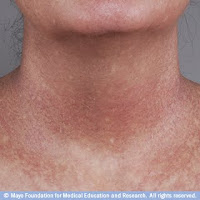Skin problems (2) : Sun Damage
Sun damage builds over time
You may walk away from the beach with a suntan, but that's not all you're getting. Excessive sun exposure is responsible for most of the sun damage associated with aging skin. This sun damage accumulates slowly over time and starts at an early age. While some of the sun damage is merely cosmetic, other effects, such as skin cancer, are more serious.
Uneven pigmentation
 To protect itself from the damaging effects of the sun, your skin increases its production of melanocytes. These cells produce the dark brown pigment called melanin. The extra melanin makes your skin look darker or suntanned.
To protect itself from the damaging effects of the sun, your skin increases its production of melanocytes. These cells produce the dark brown pigment called melanin. The extra melanin makes your skin look darker or suntanned.
Damage to darker skin
Melanin is the dark brown pigment in the top layer of skin (epidermis) that gives skin its normal color. This pigment protects the deeper layers of skin from sun damage. The more melanin in the skin, the darker the skin appears and the more protection it has against sun damage.
Solar lentigines on the forehead
 Solar lentigines, also referred to as liver spots or age spots, are flat spots of increased pigmentation � usually brown, black or gray.
Solar lentigines, also referred to as liver spots or age spots, are flat spots of increased pigmentation � usually brown, black or gray.
Solar lentigines on the back
 Solar lentigines tend to become more numerous with repeated sun exposure and with advancing age.
Solar lentigines tend to become more numerous with repeated sun exposure and with advancing age.
Labial lentigo
A dark brown lesion, called labial lentigo, can develop on the lips after repeated sun exposure. In most cases, labial lentigo is a single spot that forms on the lower lip, which is often more exposed to sunlight.
Solar elastosis
Ultraviolet radiation breaks down the skin's connective tissue � collagen and elastin fibers � which lie in the deeper layer of skin (dermis). Without the supportive connective tissue, the skin loses its strength and flexibility. This condition, known as solar elastosis, is characterized by vertical creases (A), deep wrinkles, and loose or sagging skin.
Melasma
 Also referred to as chloasma or "mask of pregnancy," melasma is a brown darkening of facial skin. Melasma likely occurs from a combination of factors, including exposure to sunlight and an increase in the female hormones estrogen and progesterone.
Also referred to as chloasma or "mask of pregnancy," melasma is a brown darkening of facial skin. Melasma likely occurs from a combination of factors, including exposure to sunlight and an increase in the female hormones estrogen and progesterone.
Poikiloderma
Irregular areas of reddish-brown pigmentation characterize poikiloderma. This condition, which occurs most often in middle-aged and elderly women, is likely caused by chronic sun exposure in combination with sun-sensitive chemicals in cosmetics or perfume. Most often, poikiloderma appears on the side of the neck or on the cheeks.
Actinic keratoses
 Also known as solar keratoses, actinic keratoses appear as rough, scaly raised patches that range in color from flesh colored to dark pink or brown.
Also known as solar keratoses, actinic keratoses appear as rough, scaly raised patches that range in color from flesh colored to dark pink or brown.
Lentigo maligna
 Lentigo maligna is a type of melanoma that develops in areas of long-term sun exposure, such as your face, hands or legs. Lentigo maligna starts as a dark flat spot that slowly darkens and enlarges.
Lentigo maligna is a type of melanoma that develops in areas of long-term sun exposure, such as your face, hands or legs. Lentigo maligna starts as a dark flat spot that slowly darkens and enlarges.





0 Komentar Untuk "Skin problems (2) : Sun Damage"
Post a Comment